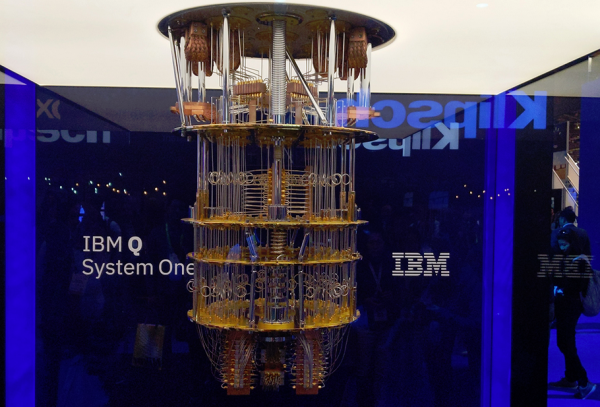IBM量子挺进由Arm驱动的Fugaku超级计算机
日本基于 Arm 的Fugaku 超级计算机将与 IBM 新开发的量子系统配对使用。此举是一个未来计算系统研究和开发项目的一部分。
俗称“大蓝”的 IBM 日前宣布了这一举措并表示已与日本政府科学研究机构理化学研究所(RIKEN)达成协议,将在神户的理化学研究所计算科学中心部署 IBM 量子系统II(Quantum System Two)并将其与 Fugaku 超级计算机进行整合。

IBM 量子系统II 与 Fugaku 超级计算机组队是为了实现以量子为中心的超级计算。IBM 视其为传统 HPC(高性能计算)的未来。量子将成为该架构不可分割的一部分。当然,前提是量子计算确实是一项切实可行的技术。
Fugaku 是富士通公司使用 152,064 个定制设计的 A64FX 处理器芯片构建的。Fugaku 在 2020 年曾是世界上已知最强大的超级计算机。 Frontier 超大规模系统则在 2022 年超越了 Fugaku。
IBM 量子系统II 于 12 月在纽约举行的年度 IBM 量子峰会上亮相,IBM 量子系统II 基于该公司的 133 量子比特 Heron 量子处理器。IBM 称 IBM 量子系统II 将是与 Fugaku 位于同一地点的唯一一台量子计算机。
Fugaku/IBM 量子系统II 的整合是日本政府新能源和工业技术开发组织(NEDO)一个资助项目的一部分,该项目旨在展示这种混合计算平台在未来“后 5G 时代”部署即服务的优势,项目的目标是推动日本的科学和商业发展。
IBM 表示除提供硬件外还将致力于开发一个软件栈,用于“在异构量子高性能计算混合计算环境中生成和执行集成量子经典工作流”。这些功能主要用于改善算法质量和执行时间。
理化学研究所量子 HPC 协作平台部门主任 Mitsuhisa Sato 博士声称,量子比特数在不断增加,保真度也在不断提高,量子系统正从有噪中等规模量子(NISQ)时代迈向实用阶段。(IBM 宣称 Heron 处理器取得的一项成就就是错误率改进了五倍)。
他表示,“量子计算机从高性能计算的角度来看是一种设备,可以加快传统上在超级计算机上执行的科学应用计算并完成一些在超级计算机上尚无法解决的计算。”
Mitsuhisa 博士表示,理化学研究所致力于开发用于量子-HPC 混合计算的软件,该研究所的科研能力以及在开发和运行 Fugaku 等超级计算机方面的经验为开发这些软件提供了很好的基础。
IBM 也对这一新进展表示欢迎,称这标志着“通向以量子为中心的超级计算未来之旅的一个重大里程碑”。
IBM 研究员兼 IBM 量子部门副总裁 Jay Gambetta 表示,“这项工作将推动行业朝着模块化和灵活的架构发展,这样的架构将量子计算和通信与经典计算资源相结合,两种计算范式能够协同工作,可以解决一些日益复杂的问题。”
日本看起来是在认真对待这一挑战,该国这次在量子经典混合计算平台方面的投资并不是唯一的投资。
量子计算公司 QuEra Computing 表示,公司已获得日本国家先进工业科学技术研究所(AIST)一份价值 65 亿日元(约合 4140 万美元)的合同,旗下的一套系统将与 Nvidia 驱动的 ABCI-Q 超级计算机部署在一起。
QuEra表示,ABCI-Q 系统有望成为量子电路仿真和量子机器学习的平台、构建经典-量子混合系统以及开发受量子技术启发的新算法。
好文章,需要你的鼓励
AI投资有望在2026年获得真正回报的原因解析
尽管全球企业AI投资在2024年达到2523亿美元,但MIT研究显示95%的企业仍未从生成式AI投资中获得回报。专家预测2026年将成为转折点,企业将从试点阶段转向实际部署。关键在于CEO精准识别高影响领域,推进AI代理技术应用,并加强员工AI能力培训。Forrester预测30%大型企业将实施强制AI培训,而Gartner预计到2028年15%日常工作决策将由AI自主完成。
北大学者革新软件诊断方式:让代码问题的“病因“无处遁形
这项由北京大学等机构联合完成的研究,开发了名为GraphLocator的智能软件问题诊断系统,通过构建代码依赖图和因果问题图,能够像医生诊断疾病一样精确定位软件问题的根源。在三个大型数据集的测试中,该系统比现有方法平均提高了19.49%的召回率和11.89%的精确率,特别在处理复杂的跨模块问题时表现优异,为软件维护效率的提升开辟了新路径。
2026年软件定价大洗牌:IT领导者必须知道的关键变化
2026年软件行业将迎来定价模式的根本性变革,从传统按席位收费转向基于结果的付费模式。AI正在重塑整个软件经济学,企业IT预算的12-15%已投入AI领域。这一转变要求建立明确的成功衡量指标,如Zendesk以"自动化解决方案"为标准。未来将出现更精简的工程团队,80%的工程师需要为AI驱动的角色提升技能,同时需要重新设计软件开发和部署流程以适应AI优先的工作流程。
德国达姆施塔特工业大学团队首次揭秘:专家混合模型AI的“安全开关“竟然如此脆弱
这项由德国达姆施塔特工业大学领导的国际研究团队首次发现,当前最先进的专家混合模型AI系统存在严重安全漏洞。通过开发GateBreaker攻击框架,研究人员证明仅需关闭约3%的特定神经元,就能让AI的攻击成功率从7.4%暴增至64.9%。该研究揭示了专家混合模型安全机制过度集中的根本缺陷,为AI安全领域敲响了警钟。
稚晖君发布全球最小全身力控人形机器人,上纬启元开启个人机器人时代
2026年软件定价大洗牌:IT领导者必须知道的关键变化
Linux 在 2026 年将势不可挡,但一个开源传奇可能难以为继
CES 2026趋势展望:全球最大科技展五大热门话题预测
人工智能时代为何编程技能比以往更重要
AI颠覆云优先战略:混合计算成为唯一出路
谷歌发布JAX-Privacy 1.0:大规模差分隐私机器学习工具库
谷歌量子AI发布新型优化算法DQI:量子计算优化领域的重大突破
缓解电动汽车里程焦虑:简单AI模型如何预测充电桩可用性
Titans + MIRAS:让AI拥有长期记忆能力
Gemini为STOC 2026大会理论计算机科学家提供自动化反馈
夸克AI眼镜持续升级:首次OTA,支持89种语言翻译







